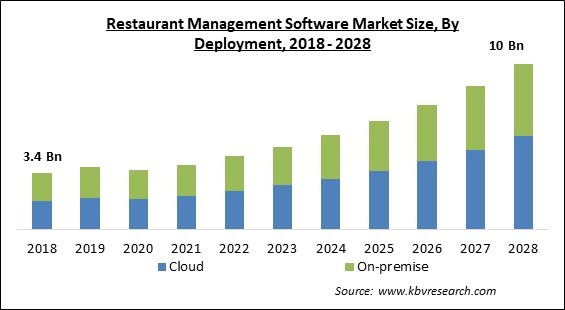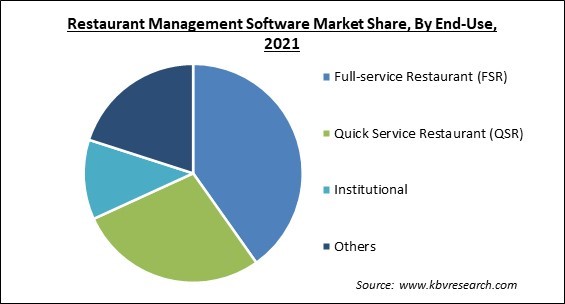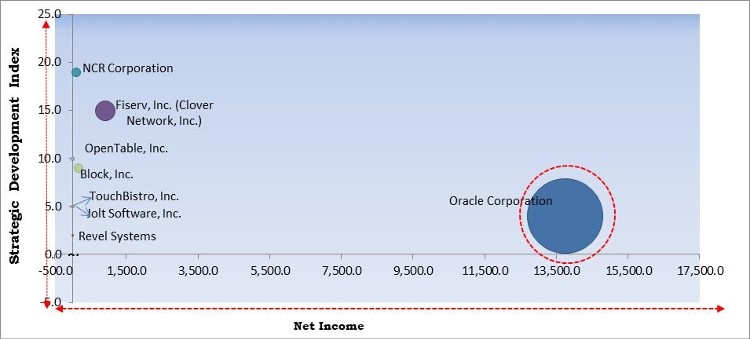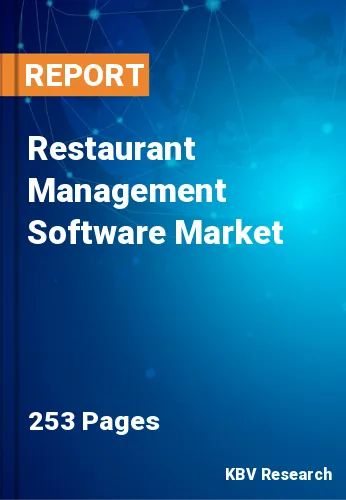The Global Restaurant Management Software Market size is expected to reach $10 billion by 2028, rising at a market growth of 14.6% CAGR during the forecast period.
Restaurant management software focuses on automating a restaurant's daily workflows. Accounting, customer contact details, and supplier data are among the features, as are restaurant-specific necessities such as customer management, order tracking, cooking management, and table bookings. In addition, the software automates guest planning and inventory control. To handle orders and billing processes, it incorporates POS tools.

Software that facilitates the streamlining of food industry operations is referred to as a restaurant management system. Specifically, eating establishments, bars, bakeries, cafes, cloud kitchens, food trucks, or delivery services. It combines all the beneficial aspects of conventional POS (Point of Sale) systems with tools for managing calls, taking reservations for tables, streamlining inventory management, handling billing, providing actionable analytics, and assisting with marketing initiatives like CRM, loyalty schemes, and establishing an online presence. Additionally, it utilizes open APIs that enable to interact with any third-party application and seamlessly integrates with existing restaurant technology systems.
To ensure data information security for the restaurant POS systems, strong regulation is now required due to the rise in the use of credit and debit cards for restaurant payments. Preventing a data breach has helped secure important corporate information from personnel and provided management more control. The use of mobile and table-side solutions, including tablets, iPods, tabletop kiosks, and table-side payments, enables the service team to provide a better client experience. Restaurant proprietors and executives may improve customer satisfaction, assess costs, and boost profits with the aid of these software tools.
The outbreak of COVID-19, which has disrupted the restaurant business, as well as the increasing demand for restaurant-specific software for invoicing and payment processing and inventory management have led to the development of restaurant management software. A public health emergency known as COVID-19 has affected nearly every business, and its long-term effects will influence the industry's growth over the forecast period. The continuous research expands upon research approach to ensure that COVID-19 problems are covered and potential future directions are explored. Based on changes in consumer demand and behavior, buying habits, supply chain rerouting, contemporary market dynamics, and government initiatives, this paper provides information on COVID-19.
Any device with an internet connection can access a cloud-based POS system. It can now view real-time labor usage percentages, productivity reports, and inventory counts. The data is instantly updated and accessible at all times from any remote location. This feature of cloud POS increases the adaptability of business operations. Additionally, cloud POS can be configured on a mobile device, letting people travel with the tools. It also offers the advantage of enabling to expand the current system's mobility by adding new mobile devices. The use of Excel spreadsheets, printed schedules, written agreements, paper timesheets, and other workforce management tools is no longer necessary.
Customers enjoy discounts, but it's not always clear how to deliver them. A solid discount program requires considerable thought and work to develop, and even more, work to put into practice. However, restaurant management software can create bespoke, dynamic discount programs, doing all the work. If a customer visits restaurant after a particular number of days, it can offer them a special discount as a reward for being a regular customer. Even better, can program an automated email to inform devoted clients of their unique offer. Customers who want to go one step further can also routinely track previous purchases in the restaurant management software, which will suggest meals at a lower price while maintaining profitability and customer satisfaction.

Lack of global system standards and low consumer knowledge are the main challenges facing the cloud POS market. Attracting customers and successfully expanding vertical markets are the main challenges facing producers of cloud POS technology. Customers require an acceptable cash substitute, but they frequently aren't aware of the options on the market. Consumers in wealthier countries tend to avoid using wireless payment cards out of security concerns, whereas consumers in poorer countries are typically unaware of wireless payment technologies. Regulatory agencies must make major efforts to inform the public about the flexible and secure data POS systems currently available.
Based on Deployment, the market is segmented into Cloud and On-premise. The cloud segment acquired the highest revenue share in the Restaurant Management Software Market in 2021. The prepared platform, which has already been created and approved by the software suppliers, is what makes cloud-based solutions simple to adopt. Restaurant operators can access data essentially from anywhere due to cloud-based solutions' direct information centralization capabilities.
Based on End Use, the market is segmented into Full-service Restaurant (FSR), Quick Service Restaurant (QSR), Institutional, and Others. The quick service restaurant segment (QSR) recorded a substantial revenue share in the Restaurant Management Software Market in 2021. Due to the factors such as POS systems, payment digitization, and rising disposable income. QSR operators can automate their business processes due to several advantages provided by restaurant management software.
Based on Software, the market is segmented into Front-end Software, Accounting & Cash Flow, Purchasing & Inventory Management, Table & Delivery Management, Employee Payroll & Scheduling, and Others. The front-end software segment garnered the highest revenue share in the Restaurant Management Software Market in 2021. The increase in supply of software solutions including customer relationship management, recipe monitoring, culinary order taking, and POS solutions is responsible for the segment growth. These POS-integrated solutions make it simple for restaurants to handle order management and payment processing.
| Report Attribute | Details |
|---|---|
| Market size value in 2021 | USD 3.9 Billion |
| Market size forecast in 2028 | USD 10 Billion |
| Base Year | 2021 |
| Historical Period | 2018 to 2020 |
| Forecast Period | 2022 to 2028 |
| Revenue Growth Rate | CAGR of 14.6% from 2022 to 2028 |
| Number of Pages | 253 |
| Number of Tables | 383 |
| Report coverage | Market Trends, Revenue Estimation and Forecast, Segmentation Analysis, Regional and Country Breakdown, Competitive Landscape, Companies Strategic Developments, Company Profiling |
| Segments covered | Deployment, Software, End-Use, Region |
| Country scope | US, Canada, Mexico, Germany, UK, France, Russia, Spain, Italy, China, Japan, India, South Korea, Singapore, Malaysia, Brazil, Argentina, UAE, Saudi Arabia, South Africa, Nigeria |
| Growth Drivers |
|
| Restraints |
|
Based on Regions, the market is segmented into North America, Europe, Asia Pacific, and Latin America, Middle East & Africa. The North America segment acquired the highest revenue share in the Restaurant Management Software Market in 2021. It is due to the Rapid urbanization, rising consumer income, the good structure of the foodservice sector, and a high level of vendor market penetration all contribute to the regional industry's growth. Additionally, the expansion of the QSR market in the area has been aided by the existence of well-known QSR chains and the widespread availability of a variety of cuisines.
Free Valuable Insights: Global Restaurant Management Software Market size to reach USD 10 Billion by 2028

The major strategies followed by the market participants are Acquisitions. Based on the Analysis presented in the Cardinal matrix; Oracle Corporation are the forerunners in the Restaurant Management Software Market. Companies such as Fiserv, Inc., NCR Corporation and Block, Inc. are some of the key innovators in the Market.
The market research report covers the analysis of key stake holders of the market. Key companies profiled in the report include Block, Inc., Fiserv, Inc. (Clover Network, Inc.), NCR Corporation, Oracle Corporation, Revel Systems, Personica, Jolt Software, Inc., OpenTable, Inc., TouchBistro, Inc., and Fourth Enterprises LLC.
By Deployment
By End Use
By Software
By Geography
The global restaurant management software market size is expected to reach $10 billion by 2028.
Simple to use, with increased flexibility and mobility for enterprises are driving the market in coming years, however, Low amount of awareness and standardization limited the growth of the market.
Block, Inc., Fiserv, Inc. (Clover Network, Inc.), NCR Corporation, Oracle Corporation, Revel Systems, Personica, Jolt Software, Inc., OpenTable, Inc., TouchBistro, Inc., and Fourth Enterprises LLC.
The expected CAGR of the restaurant management software market is 14.6% from 2022 to 2028.
The Full-service Restaurant (FSR) segment is leading the Global Restaurant Management Software Market by End-Use in 2021, and would continue to be a dominant market till 2028; thereby, achieving a market value of $3.86 billion by 2028.
The North America market dominated the Global Restaurant Management Software Market by Region in 2021, and would continue to be a dominant market till 2028; thereby, achieving a market value of $3.59 billion by 2028.
Our team of dedicated experts can provide you with attractive expansion opportunities for your business.

